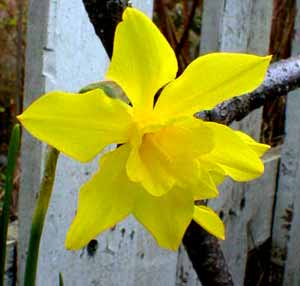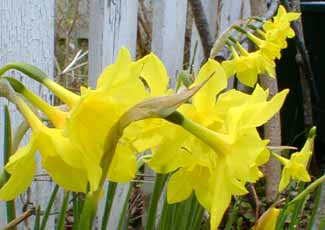
Campernelle Jonquil;
aka, Narcissus 'Rugulosus'
"I wandered lonely as a cloud
That floats on high o'er vales & hills,
When all at once I saw a crowd
A host of golden daffodils;
Beside the lake, beneath the trees,
Fluttering and dancing in the breeze."
- William Wordsworth,
Daffodils, 1804
Daffodils, 1804
This cloned Narcissus odorus originated as a hybrid of the wild Jonquil (N. jonquilla) with the Lent Lily (N. pseudonarcissus). Despite that it is a hybrid it is regarded as a botanical narcissus because it was discovered as a wildflower in the eastern Mediterranean region, where spontaneous crosses of wild daffodils & wild jonquils were first reported in 1595 & in 1601.
It is designated the Campernelle Jonquil, occasionally listed as though it were its own species, N. campernelli. It is also sometimes called by the name 'Rugulosus,' or even as though it were a taxonomic variant, R. odorus var. rugulosus.
 Generally it is sterile, but reproduces very well by offsets. It is so extremely hardy in the sunny south it has managed, despite its sterility, to naturalize in rural areas where it was gardened so long ago that houses & gardens have vanished, but Campernelles persist. It is also possible that seedlings do occasionally appear wherever fertile jonquils & lent lilies are growing in proximity.
Generally it is sterile, but reproduces very well by offsets. It is so extremely hardy in the sunny south it has managed, despite its sterility, to naturalize in rural areas where it was gardened so long ago that houses & gardens have vanished, but Campernelles persist. It is also possible that seedlings do occasionally appear wherever fertile jonquils & lent lilies are growing in proximity.As a "Southern heirloom" it has persisted for generations especially in very old gardens, tended or untended, in Louisiana, Virginia, Arkansas & the Carolinas. They can be delicate in zone 6 or 7, & most certainly need protection in zone 5. In the coastal Pacific Northwest (zone 8), they are at slight risk of damage, for they can bloom early enough that late-occurring frosts could in some years get them.
They can bloom as early as February, or as late as April. Generally they are not troubled by Puget Sound weather. Their grass is up by January & they are in full bud by mid-February but do not actually burst into flower until the first week of March, when frosts are either through for the winter, or too momentary-at-dawn to cause harm.
We have fairly dry summers despite the region's reputation for rainfall, & the dry dormancy they require is easily provided, so that they do adapt here very well, so long as they have well-draining soil & a sunny position. Campernelles are also a good choice for indoor winter forcing.
In autumn 2003, we placed ten bulbs, obtained from a southern grower. We put them in full afternoon sun underneath the mail box by the back gate. Since we visit the mailbox daily, & it's by our most often used gate besides, this seemed the best possible location to insure our daily appreciation of Campernelle's promised perfume.
it is said by many to have a most wonderful scent, but it turned out to be more subtle than I'd expected from all the praise. Some scented daffodils can be oppressive with their redolence when brought indoors, & the subtlty of the Campernelles would be preferred for indoor bouquets. Left in the garden, though, one has to get down close to the flowers to smell them at all.
A semi-dwarf narcissus in the eight to thirteen inch range, the flowers occur one or two & occasionally up to five per scape, pure yellow blooms sharply bent at the neck amidst reedy foliage. The perianths' petals have an unusual whirligig's "twist" to them behind the flared ruffled cup, so they are stand-outs among other basic yellow daffodils, easily distinguished.
See also the Double Campernelle which was accidentally with the regular campernelles.